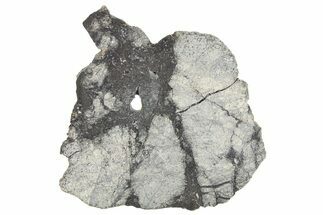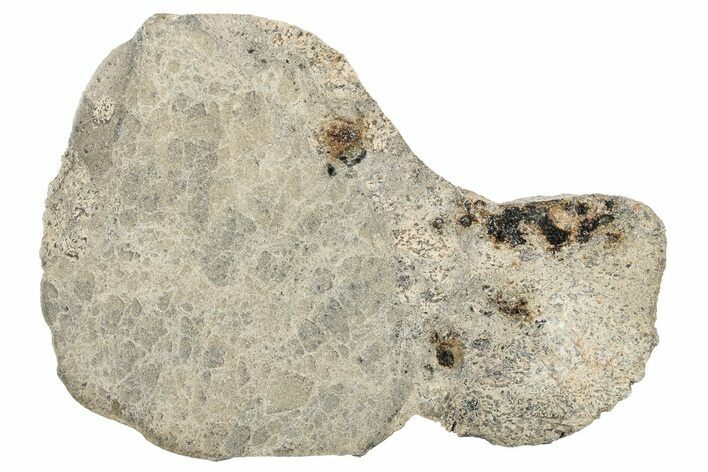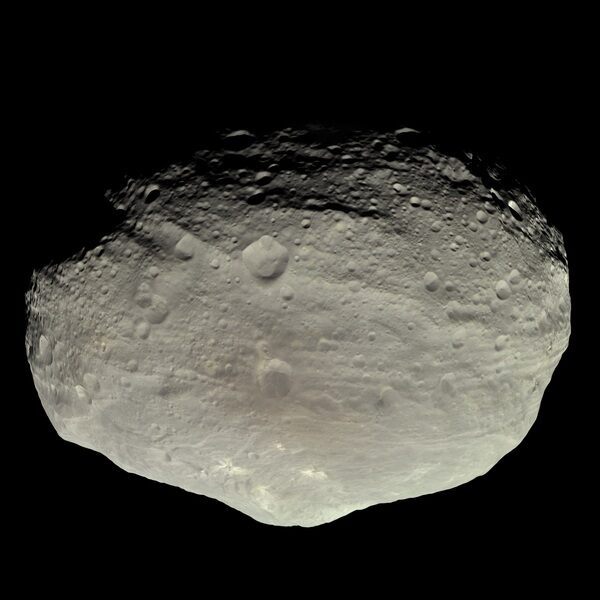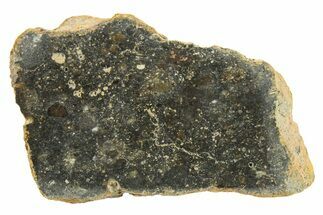This Specimen has been sold.
4.3" Eucrite Meteorite Slice (64.5 g) - Jikharra 001
This is a 4.3" wide slice (64.5 gram) from the Eucrite meteorite, Jikharra 001. The meteorite has been sliced and polished to a glossy finish on one side, and is accompanied by an acrylic display stand.
About Jikharra 001
This specimen is part of the 2022 find in Libya, Africa. Approximately 3 tons of this eucrite were found, making it not only the largest eucrite meteorite found, but the second largest stony meteorite fall ever discovered!
Jikharra 001 is an HED achondrite (eucrite-melt breccia) composed of several centimeter-sized lithic clasts set in abundant recrystallized shock melt. These clasts consist of calcic plagioclase and aggregates of fine-grained, 30-70 µm pigeonite crystals with patchy compositional zoning. The melt matrix is composed of recrystallized pigeonite displaying mottled compositional zoning and fine-grained, mostly fibrous feldspar. Minor phases include silica, Ti-chromite, ilmenite, and FeS. This meteorite also often displays patches of fusion crust.
This specimen is part of the 2022 find in Libya, Africa. Approximately 3 tons of this eucrite were found, making it not only the largest eucrite meteorite found, but the second largest stony meteorite fall ever discovered!
Jikharra 001 is an HED achondrite (eucrite-melt breccia) composed of several centimeter-sized lithic clasts set in abundant recrystallized shock melt. These clasts consist of calcic plagioclase and aggregates of fine-grained, 30-70 µm pigeonite crystals with patchy compositional zoning. The melt matrix is composed of recrystallized pigeonite displaying mottled compositional zoning and fine-grained, mostly fibrous feldspar. Minor phases include silica, Ti-chromite, ilmenite, and FeS. This meteorite also often displays patches of fusion crust.
Eucrite Meteorites - Fragments Of 4 Vesta
Eucrites are achondritic stony meteorites thought to have originated from the surface of the giant asteroid (or minor planet) 4 Vesta. Vesta is the second largest body in the asteroid belt, measuring 326 miles wide. Like Earth, it has the differentiated layers of crust, mantle, and core common to rocky planets: this may mean that 4 Vesta is the remnant of a larger destroyed planet.
Eucrites consist of basaltic rock from Vesta's crust ejected during a collision with another asteroid. Eucrites are mostly composed of calcium-poor pyroxene, pigeonite, and calcium-rich plagioclase (anorthite). Vesta is currently one of just seven identified solar system bodies of which we have physical samples.
Eucrites are achondritic stony meteorites thought to have originated from the surface of the giant asteroid (or minor planet) 4 Vesta. Vesta is the second largest body in the asteroid belt, measuring 326 miles wide. Like Earth, it has the differentiated layers of crust, mantle, and core common to rocky planets: this may mean that 4 Vesta is the remnant of a larger destroyed planet.
Eucrites consist of basaltic rock from Vesta's crust ejected during a collision with another asteroid. Eucrites are mostly composed of calcium-poor pyroxene, pigeonite, and calcium-rich plagioclase (anorthite). Vesta is currently one of just seven identified solar system bodies of which we have physical samples.
TYPE
HED Achondrite (Eucrite-Melt Breccia)
AGE
LOCATION
Libya
SIZE
4.3 x 3.1", 0.12" thick, 64.5 grams
CATEGORY
SUB CATEGORY
ITEM
#284823
 Reviews
Reviews













